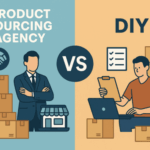Crafting an effective digital product strategy means navigating uncharted waters with a well-drawn map. It helps businesses create a product that is marketable to their target consumers and ensures that they remain relevant and dominant in the market. It is not only a document but a continuously evolving process following the switch to new technologies and changing customer expectations.
Modern digital strategies focus on flexibility, creativity, and the use of analyses. These aspects distinguish them from traditional product planning that tends to involve well-defined frameworks and numerous stages. Those businesses which have not changed to the new direction might end up being incompetent to meet the needs of the contemporary consumer.
Understanding the Shift from Traditional to Digital Product Planning
Flexibility has become critical for the management of organizations in the current global economy necessitating a shift from the traditional product planning process. The conventional approaches still tend to have quite a linear way of thinking which may sometimes be compared to the “set it and forget it” mentality, with strict time intervals and scarce opportunities for feedback. The methods are suitable in the predictive market; however, the digital market is unpredictable.
The strategies related to the digital product are quite flexible since they incorporate Agile and lean approaches that always improve. For instance, organisations embrace digital solutions that may allow a company to launch a minimum viable product (MVP), and instead of taking a number of months, get reactions, and enhance it.
The difference is not only theoretical but logical. According to Gartner, organizations adopting Agile digital product strategies are 60% more likely to meet customer expectation goals than those relying on traditional methods. The reason is simple digital strategies adopt change while traditional planning resists it.
Common Pitfalls in Digital Product Strategy
Digital strategies have immense potential, but still, they are not foolproof. Many companies falter by making avoidable mistakes.
Avoiding customer Feedback:
One of the most common errors is ignoring customer feedback. While developing a product, businesses must remember to involve the end users, as it is like building a bridge without understanding the river flow. For example, Nokia’s downfall in the smartphone market was largely due to its disregard for consumer demand.
Adaptability of Latest Technology:
Another significant error is the inability to adopt emerging trends. In a world where technology like blockchain, AI, and IoT are redefining industries, staying stagnant is not an option.
Take Kodak, for example. They invented digital photography but didn’t embrace it, and it cost them their place in the market. It’s a clear reminder of why adapting to change is so important.
Simplifying the strategies:
Lastly, complicating strategies leads to paralysis in execution. Sophistication and simplicity are sometimes the ultimate solutions in crafting a digital product strategy. Execution is seamless and hassle-free.
Pro Tip:
Businesses should adopt a culture of learning and flexibility, stepping rather than stumbling blocks.
The Crucial Role of Data in Shaping Product Strategy
Data is the backbone of the decision-making process. Data is used in decision making processes of any business starting from user preferences to market trends.
Netflix is one of the best examples to have emerged when talking about data-driven strategies. It predicts what people watch to provide content based on their choice. After that, it also utilizes these understandings to select what new programs and movies it should develop, making it continue its position as a leader in the entertainment business.
Numerically, companies that integrate data into their marketing communication initiatives are 23x more likely to capture the consumers’ attention, and 19 times more likely to retain their attention, as analyzed by McKinsey.
How to Use Data Effectively?
- Analytics Tools: Platforms like Google Analytics and Amplitude help track user behavior.
- A/B Testing: Experimenting with different product features or interfaces can reveal what resonates most with users.
- Customer Feedback: Direct input from customers through surveys or reviews provides qualitative insights.
Incorporating these practices ensures that your digital product strategy is grounded in reality rather than assumptions.
Aligning Your Digital Strategy with Customer Experience Goals
Here is a general fact: every digital product has a customer experience (CX); a product may contain such features that are perceived as a breakthrough, but a product will most likely fail anyway due to a bad customer experience.
CX isn’t just a cliché; It can be seen as a decisive, key variable in people’s consumption choices. According to Glass Box research conducted in 2024, 86% of customers are willing to spend more money to get a good experience to stress on it.
Streamlining your digital product strategy with CX includes understanding the customer journey and highlighting their pain points. For instance, Amazon excels by providing personalized recommendations, smooth returns, and a one-click purchasing option. These small efforts culminate in a superior customer experience that retains the users.
To achieve this, businesses must adopt a user-centric approach. Conduct usability tests, create innovative designs, and ensure that every touchpoint reflects your brand’s commitment to quality.
Integrating Insights for a Holistic Approach
A successful digital product strategy is not about avoiding mistakes, it’s about combining these elements into a cohesive planning.
Think about a car where the engine (data), tires (customer experience), and brakes (flexibility) work Independently. They would not go far. Similarly, an effective strategy requires all components to work together simultaneously.
Set clear goals, whether for customer attention, market expansions, or launching a new product. Your goal should be concise and clear. Next, make sure your team, from marketing to development, is streamlined according to these goals. Collaboration acts like glue that holds a strategy together.
Last but not least, keep a close eye on market evolution, competitor innovations, and consumer behavior shifts, and regularly revise and refine your strategies to make them relevant and effective.
Conclusion: Successful Digital Product Strategy for Long-Term Success
Therefore, building an effective digital products strategy is not easy, and every ounce of effort is essential. Thus, by appreciating the significance of digital planning, avoiding typical mistakes, leveraging data opportunities, and orienting the objectives of customer experience, companies can design products that will be recognized among the crowd.
In other words, the saying, “A stitch in time saves nine,” is true. Customer-oriented strategy is an investment that can greatly pay off in the future; all you need to do is make the necessary investment now. More to the point, a successful strategy does not immediately pay off—it lays a basis for firmly sustainable growth. Any firm that clearly understands its strategy, in addition to achieving competitive advantage, will also be well protected in case of any unfortunate event in the future.
Digital product strategy is not about tools or data alone; it is about people. It is about engaging your team, educating them, creating creativity, and then sharing it.
The pace at which organizations are adopting digital innovations will not decline any time soon; the idea here is to keep adapting and evolving. This announcement forces companies to look at their strategy because it will assist them in discovering their greatest opportunities and establishing a strong foundation for their organization. Finally, a product created with passion and a clear purpose always strikes a chord with its users.
The road to success in the digital age is challenging, but those who embrace the journey with a clear vision and an agile mindset are destined to leave a mark.
Discover More with Brand New MD’s Newest Articles
Following are the newest articles from Brand New MD:
- The Definitive Guide to Product Sourcing for Amazon FBA
- Mastering Product Strategy: An Expert’s Guide
- Product Development Team Structure Explained
- How Many Sourcing Types in Supply Chain Management?
- 20 Effective Product Marketing Examples You Need to See
References:
- Gartner Research: Digital Business Strategy (gartner.com)
- Glassbox: The Ultimate Guide to Digital Customer Experience (glassbox.com)
- McKinsey Insights: Data-Driven Decision Making (mckinsey.com)









